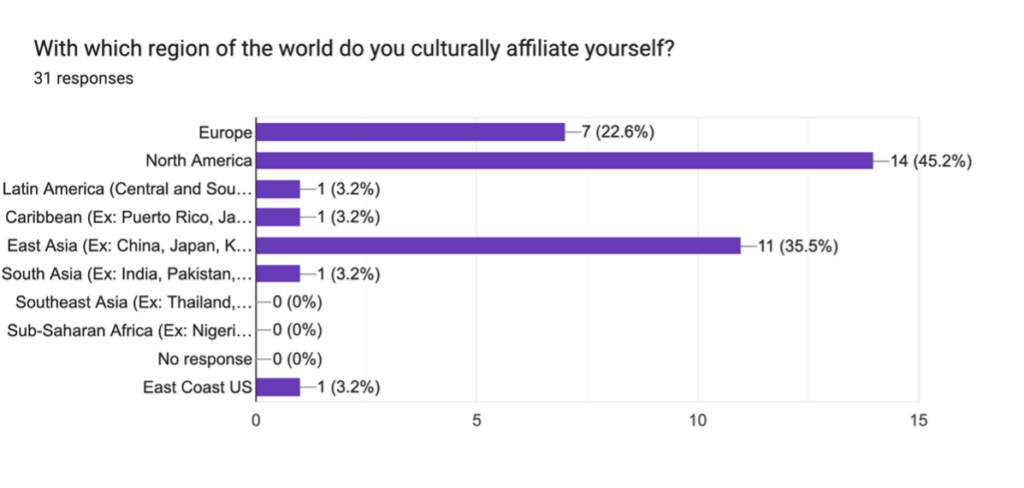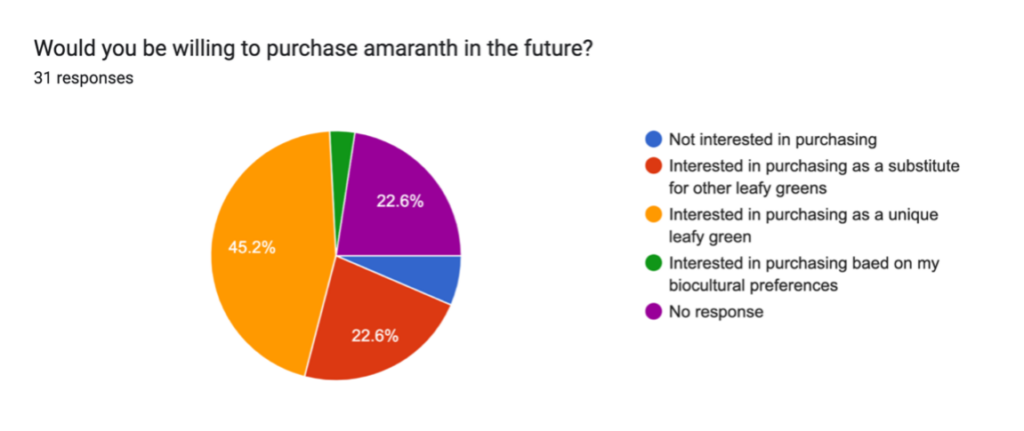Final report for GNE22-299
Project Information
The purpose of this project is to facilitate crop introduction while standardizing and improving production systems and marketing of ethnoculturally preferred leafy green amaranth towards minoritized ethnic communities, focusing on cultural preference and nutrition. This was completed through a large-scale outdoor variety trial with individual plant selections, and evaluation of plant growth in outdoor and indoor environments on the four most promising varieties, based on cultural preference and growth quality in New Jersey. These four varieties were further evaluated as multiple-harvest crops, to determine change in yield and plant quality over multiple harvest stages. Farmer selections and consumer preference surveys were simultaneously conducted to maintain the cultural relevance of these greens. Based upon the results, we conclude that consumers are willing and excited to purchase these greens either as culturally relevant options or as unique summer greens, as local summer green production is limited due to the intolerance of mainstream leafy greens like spinach, kale, and Swiss chard to extreme heat conditions. Through crop selection and field performance evaluations, our lab is close to introducing new commercial amaranth varieties into the market, each one representing a different customer base due to their cultural expectations relative to their distinct phenotypes and the nutritional benefits of these greens.
Project objectives:
- Complete variety trials on leafy green amaranth in an outdoor and hydroponic farm setting to compare yield and nutritional quality.
- Evaluate single harvest and multiple harvest methods based on yield, consumer preference, and environmental sustainability.
- Assess consumer response to the introduction of different varieties in farmers markets.
Parallel to the above objectives, collaborating farmers will be invited to tour the fields and provide their own assessment as to which leafy green amaranth cultivars are of greatest interest. In this way, we will be incorporating a ‘participatory approach’ to selection (pre-breeding strategies) based upon the industry inputs, therefore ensuring the relevancy and connections to small-scale New Jersey growers.
Demand for ethnocultural leafy greens in the US is rising rapidly due to the increased awareness among cultural groups about their culinary heritage and the desire for diverse and healthy diets (Govindasamy et al., 2016). This demand is heightened when considering the disproportional effects of food insecurity on minoritized ethnic populations. Mousa and Freeland-Graves (2009) determined that food-insecure clients of food pantries were significantly more likely to have spent a shorter duration living in the US and were more overweight compared to those that were food secure. This is attributed to the lack of culturally familiar, nutrient-dense foods that are available at an affordable price. Leafy green amaranths (Amaranthus spp.) are among the most popular culturally preferred leafy greens across African Diaspora, Latino, South and East Asian communities (Govindasamy et al., 2016). These communities make up 65% of New Jersey’s population, according to the 2020 state census. This crop has the potential to serve as a model for ethnocultural crop introduction due to its immense cultural desire, nutrient-density, and ease in growing.
The global use of amaranth as a leafy green makes it an optimal target for crop introduction in the Northeastern United States, which relies on high-value specialty crops. Along with ethnocultural favorability, amaranth plants are heat-loving and tolerant to drought and salt stress (Palmeros-Suárez et al., 2021). Its leaves are comparable to spinach in vitamin and mineral content (Chawla et al., 1988), which encourages the nickname of “Summer Spinach” to consumers that would consider this crop as a novel summer green. This marketing approach encourages the supplementation of spinach in summer months, increasing the availability of year-round locally grown produce in the Northeast. Amaranth is also being grown hydroponically as a baby green, which maximizes its production time and reduces its threat as a weedy species in open-field agriculture. Benefits of hydroponically grown leafy green amaranth also include maximization of nutritional content and cleaner harvested products (Gilmour et al., 2019).
Despite ethnocultural desire for amaranth, its production has not been made a priority to specialty crop farmers because of its association with the weeds or ‘pigweeds’ of the Amaranthus genus. In reference to agricultural sustainability, this project strives to emphasize to farmers the importance of harvesting crops before they flower. Amaranth plants have limited root systems, so their weedy tendencies are due to the abundance of seeds (typical of wind-pollinated species) produced by a single plant and vigorous growth in the hot summer months. Selection for very late flowering amaranth cultivars is a large consideration in these field trials to reduce likelihood of plants seeding in the field. Govindasamy et al. (2016) highlighted that current methods of crop rotation, cultivation and other weed control strategies used are sufficient means of recovering a mismanaged field of amaranth greens that go to seed. As consumer awareness of this crop increases, amaranth has the potential to penetrate Northeastern markets as an ethnoculturally familiar crop and as a summer alternative to spinach.
New Jersey’s small-scale farmers, both outdoor and indoor, will benefit from being early producers of leafy green amaranth. Because of the existing ethnocultural diversity in the Northeastern US, consumer acceptance of leafy green amaranth will begin in New Jersey and has the potential to expand to the rest of the country. Establishing leafy green amaranth as a specialty crop in New Jersey gives small-scale farmers an edge on larger manufacturers that currently dominate the produce market (Govindasamy et al., 2010; Fouladkah et al., 2011). The introduction of leafy green amaranth presents an opportunity to simultaneously address food security and market demands among New Jersey’s growing culturally diverse population while providing small-scale farmers with a competitive advantage through a nutrient-dense, heat tolerant crop that serves both traditional and mainstream markets.
Cooperators
- (Educator and Researcher)
- (Educator and Researcher)
- (Educator and Researcher)
Research
Objective 1:
An outdoor field experiment was conducted to evaluate 97 amaranth cultivars, following commercial agricultural practices. These cultivars were collected from international seed banks (USDA-Grin and World Vegetable Center), from commercial American seed companies and our own Rutgers selection and breeding lines. The experiment employed a randomized complete block design (RCBD) with three spatial blocks. Each experimental unit consisted of eight plants per cultivar, with data collected from the middle five plants as subsamples. In the second year, 38 of the original 97 cultivars were retained for further evaluation. The study design allowed for separate analyses of each year's data, as well as an ad hoc combined analysis of the 38 cultivars present in both years. Response variables measured included fresh weight, internode length, leaf area (of the youngest fully expanded leaf), plant height, dry weight, basal stem diameter, total antioxidants, total polyphenols, total β-carotene, total chlorophyll, estimated total protein, and mineral nutrients. Prior to combining data across years, cultural practices were examined for consistency to determine the appropriateness of a combined analysis.
The top four varieties were then trialed in an outdoor and indoor cultivation setting, each taking place within 5 weeks from seed to harvest. The outdoor field trial was completed in June-July of 2023 and again from August-September 2023. The indoor hydroponic trial was completed in August-September 2024. An ebb-and-flow system was used in a growth chamber, to replicate growing conditions that would be found inside of a vertical farming operation. The plants were subjected to 18 hours of light, with a light intensity of 400-500 µmol m-2 s-1 . The system was irrigated once daily, with recirculating fertigation of deionized water and a 21-5-20 fertilizer, at a pH of 5.5-6.5 and EC of 1.2-1.8. Sodium bicarbonate was used to raise pH. Plants were grown in peat moss and vermiculite (50:50 ratio) for 5 weeks from seed to harvest. Fresh and dry weights were taken, along with total antioxidants, phenolics, chlorophylls, provitamin A, and betalain pigments for nutritional analysis. These same top four performing varieties were also grown in a traditional outdoor field for 5 weeks, in the summer of 2023, to compare the nutritional composition of plants in an indoor and outdoor environment.
Objective 2:
In the summer of 2024, the four established Rutgers amaranth breeding lines were involved in a study to evaluate harvest intervals, assessing the quality of amaranth greens in multiple harvest intervals throughout the summer growing season. Seeds were sown in trays inside of a greenhouse for three weeks, before being transplanted at Rutgers Hort Farm 3 in East Brunswick, NJ and Rutgers Snyder Farm in Pittstown, NJ. The fields were set up in a Split Plot Design with three spatial blocks. Plants were harvested twice within eight weeks. Harvesting was done on the top third of all eight plants within a plot, allowing for one or two weeks of regrowth. A control group was set up to have one harvest of the top third at the end of the eight weeks, thereby comparing total accumulated yield in each treatment.
|
Regrowth period (weeks) |
Initial cut age (days after transplanting) |
Once-over harvest (at 6 weeks after transplanting) |
|
|
|
21 |
31 |
Positive control |
|
1 |
Trt 1 |
Trt 2 |
Trt 5 |
|
2 |
Trt 3 |
Trt 4 |
|
Table 1. Experimental design of the multiple harvest interval study, treatments 1-4 represent 21-31 days after transplanting for the first harvest and 1-2 weeks after the first harvest for the second harvest. Treatment 5 serves as the control, with one harvest 6 weeks after transplanting.
Objective 3:
In the summer of 2023, a pilot survey was introduced in two local farmers markets to assess consumer response to amaranth greens, either as a unique new leafy green or a culturally important green. IRB approval number Pro2023001032. The survey was provided in English, Mandarin, and Spanish to ensure there was no language barrier limiting the number of survey responses. In the Rutgers Cook farmers market, located at 130 Log Cabin Rd, East Brunswick, NJ 08816, consumers responded voluntarily. At the New Brunswick community farmers market, located at 78 Jones Ave, New Brunswick, NJ 08901, respondents received one market buck for completion of the survey.
In the summer of 2022, 38 cultivars of amaranth were grown in a replicated field study to make selections based on field performance, nutrient-density, and biocultural preferences, as previously defined by Govindasamy et al. (2016). Agronomic selections were made for short plants with small internodes and large total leaf area, without sacrificing fresh and dry weight (Table 2). It is important to note that plants were harvested 10 cm above ground, so higher fresh and dry weights can be attributed to large stems, which does not necessarily correlate to higher marketable yield. Phytochemical content was also considered as selection criteria, namely total antioxidants, phenolic compounds, provitamin A estimated as beta-carotene, and total chlorophyll (Figure 1). From these selection criteria, standout varieties included AM25, AM90, AM98, and AM129 (Figure 2). Each of these varieties fit into one biocultural demographic correlating with their preference in amaranth leafy greens. African Diaspora and Caribbean populations select green plants like AM90 and AM129, our “callaloo” varieties, South and East Asian communities select bicolored leaves, as seen in AM25, our “yen choy” or Chinese spinach variety, and South Asians also preferred red amaranth, as seen in AM98. These four varieties continued to be assessed in an outdoor field environment in June-July 2023 and again in August-September 2023 and an indoor controlled environment hydroponics system in August-September 2024.
Table 2. Agronomic traits used for selection criteria for the 38 cultivars grown in 2022.
|
Entry |
Plant ht (cm) |
Internode length (cm) |
Total leaf area (cm2) |
Fresh wt per plant (kg) |
Dry wt per plant (g) |
|
AM005 |
54.60 |
2.34 |
1344.09 |
2.44 |
0.14 |
|
AM012 |
40.73 |
2.42 |
1866.87 |
1.82 |
0.08 |
|
AM015 |
43.87 |
2.19 |
560.3 |
0.44 |
0.03 |
|
AM022 |
48.67 |
2.20 |
1022.35 |
2.26 |
0.12 |
|
AM025 |
48.93 |
2.94 |
2381.67 |
1.75 |
0.09 |
|
AM026 |
59.21 |
2.86 |
2327.2 |
3.23 |
0.20 |
|
AM028 |
51.33 |
2.75 |
858.86 |
2.63 |
0.13 |
|
AM030 |
55.53 |
2.45 |
1453.50 |
2.19 |
0.11 |
|
AM037 |
38.87 |
2.04 |
646.29 |
1.93 |
0.12 |
|
AM043 |
70.00 |
3.12 |
1532.35 |
2.39 |
0.13 |
|
AM051 |
48.79 |
2.59 |
937.64 |
1.33 |
0.07 |
|
AM052 |
35.60 |
2.92 |
1482.95 |
0.98 |
0.05 |
|
AM062 |
45.27 |
2.26 |
676.14 |
2.28 |
0.14 |
|
AM082 |
51.07 |
2.60 |
2014.33 |
2.21 |
0.14 |
|
AM083 |
58.60 |
2.39 |
2700.37 |
2.88 |
0.17 |
|
AM085 |
47.53 |
2.57 |
2232.22 |
2.06 |
0.11 |
|
AM087 |
50.00 |
2.32 |
2032.96 |
2.67 |
0.14 |
|
AM088 |
42.33 |
2.44 |
1773.67 |
1.97 |
0.11 |
|
AM089 |
29.27 |
2.15 |
1650.82 |
1.43 |
0.07 |
|
AM090 |
18.13 |
1.35 |
847.56 |
0.88 |
0.04 |
|
AM092 |
51.13 |
3.19 |
1950.24 |
2.17 |
0.12 |
|
AM093 |
60.62 |
3.01 |
1272.93 |
2.08 |
0.10 |
|
AM095 |
60.93 |
3.47 |
1370.80 |
1.48 |
0.08 |
|
AM097 |
49.13 |
2.75 |
2196.19 |
1.94 |
0.10 |
|
AM098 |
42.27 |
2.45 |
1797.78 |
1.92 |
0.09 |
|
AM101 |
47.20 |
2.40 |
1568.68 |
1.87 |
0.08 |
|
AM104 |
56.38 |
3.19 |
1447.39 |
1.76 |
0.11 |
|
AM105 |
30.21 |
1.99 |
1098.94 |
0.77 |
0.04 |
|
AM106 |
33.53 |
2.17 |
2159.85 |
1.71 |
0.11 |
|
AM108 |
51.43 |
2.39 |
1511.60 |
1.91 |
0.10 |
|
AM114 |
30.07 |
1.69 |
2359.50 |
1.4 |
0.08 |
|
AM120 |
12.07 |
0.90 |
124.86 |
0.05 |
- |
|
AM124 |
56.6 |
3.11 |
2046.39 |
3.80 |
0.25 |
|
AM125 |
57.40 |
2.63 |
2602.10 |
2.83 |
0.13 |
|
AM126 |
69.07 |
2.79 |
2006.88 |
3.27 |
0.22 |
|
AM129 |
25.20 |
1.49 |
1406.69 |
1.41 |
0.07 |
|
AM131 |
41.60 |
2.46 |
936.29 |
0.82 |
0.04 |
|
Average |
46.30 |
2.46 |
1572.95 |
1.92 |
0.11 |
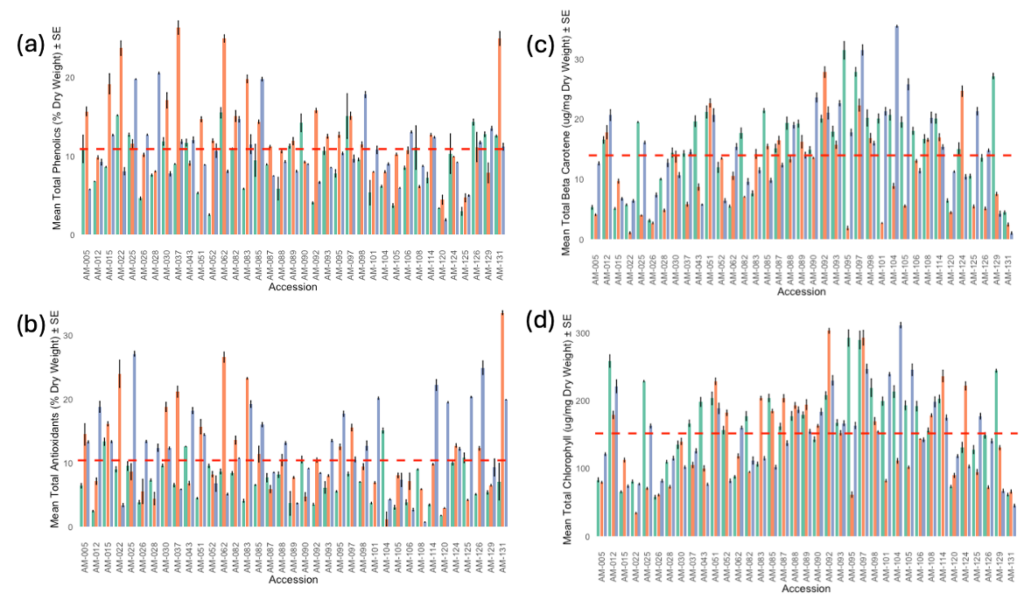
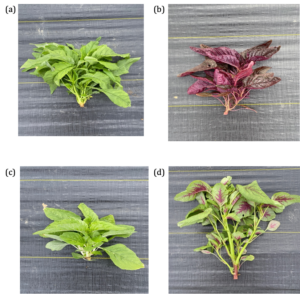
The subsequent outdoor and indoor trials for our four advanced breeding lines were conducted for 5 weeks from seed to harvest. In that time, field plants grew into mature greens, averaging 82.5-127.5 g grams fresh weight, while hydroponically grown plants were grown in smaller container sizes as baby greens, averaging 2.78 grams fresh weight (Table 3). While field-grown plants offer a larger harvest from a single plant, indoor plants allow for denser planting, maximizing the amount of young, tender leaves and stems that can be marketed and sold. Indoor growing also offers access to these greens throughout the entire year, rather than being limited to the summer months. Antioxidant concentration was highly significantly greater in all amaranth lines grown in an indoor hydroponic system versus those grown outdoors (Table 4). This is likely due to the increase in medicinal betalain pigment accumulation in the indoor systems, which was significantly greater than outdoor grown plants in AM98 and AM90. AM90 also showed a significant increase in total phenolic compounds while the rest increased in an indoor system, but that increase was not significant. This study indicates that plants grown in an indoor system with regular fertigation and artificial supplemental lighting can be induced to exhibit higher nutritional content, while also increasing the planting density to maximize the number of baby greens grown in a small space.

|
|
Fresh Weight (g) |
Dry Weight (g) |
||||
|
|
Outdoor 1 |
Outdoor 2 |
Indoor 1 |
Outdoor 1 |
Outdoor 2 |
Indoor 1 |
|
Am25 |
130 ± 20 |
120 ± 70 |
2.9 ± 0.57 |
11.2 ± 2.4 |
11.1 ± 7.1 |
0.25 ± 0.05 |
|
Am90 |
80 ± 10 |
30 ± 10 |
2.5 ± 0.22 |
7.3 ± 0.7 |
2.6 ± 1.0 |
0.23 ± 0.02 |
|
Am98 |
150 ± 40 |
80 ± 40 |
3.6 ± 0.68 |
13.1 ± 3.4 |
6.3 ± 3.6 |
0.31 ± 0.06 |
|
Am129 |
150 ± 40 |
100 ± 40 |
2.1 ± 0.16 |
13.4 ± 3.2 |
8.5 ± 3.5 |
0.28 ± 0.01 |
|
Average |
127.5 |
82.5 |
2.78 |
11.25 |
7.13 |
0.27 |
Table 3. Fresh and dry weight of 4 advanced Rutgers lines grown twice in an outdoor field and once in an environmentally controlled growth chamber. Fresh weight was taken 5 weeks after seeds were sown, and dry weight was taken 1 week after fresh weight.
|
|
Total Antioxidants (% Dry Weight) |
Total Phenolics (% Dry Weight) |
Total Betalains (ng/100 g DW) |
||||||
|
|
Outdoor 1 |
Outdoor 2 |
Indoor 1 |
Outdoor 1 |
Outdoor 2 |
Indoor 1 |
Outdoor 1 |
Outdoor 2 |
Indoor 1 |
|
Am25 |
12.57 |
12.87 |
63.47*** |
17.51 |
13.40 |
22.98 |
7.24 |
4.84 |
18.73** |
|
Am90 |
16.40 |
13.05 |
61.00*** |
13.28 |
14.32 |
20.49* |
3.44 |
3.22 |
11.79** |
|
Am98 |
17.22 |
13.04 |
55.18** |
14.32 |
12.84 |
16.57 |
17.13 |
8.32 |
42.67* |
|
Am129 |
9.50 |
7.61 |
38.05** |
16.27 |
11.37 |
14.71 |
3.17 |
3.86 |
10.90** |
*** P < 0.001, ** P < 0.01, * P < 0.05
Table 4. Nutritional content of 4 advanced Rutgers lines grown twice in an outdoor field and once in an environmentally controlled growth chamber. Plants were harvested 5 weeks after planting and dried for one week before nutritional analysis.
Our four Rutgers breeding lines were also grown in two outdoor locations in the summer of 2024 to determine the efficiency and quality of crops grown for multiple harvests. The experiment was set up as a randomized split plot design with 4 treatments of various harvest intervals and a control with a single harvest at the end of the growing cycle (Table 1). The top third of each plant was harvested, representing the marketable yield including young leaves and tender stems. Treatment groups were then regrown for either one or two weeks before their second harvest, again harvesting the top third of the plant. Fresh weight was calculated by combining the two harvests for each treatment and comparing them to the single harvest at the end of the six-week planting cycle (Figure 4). In varieties AM129, AM25, and AM90, treatment 4 accumulated the most biomass, where we waited 31 days before the first harvest and 2 weeks before the second. Treatment 2 accumulated the highest biomass for AM98, in which we harvested first at 31 days and then the following week. Further nutritional evaluation will be conducted to determine the quality of leafy greens at each harvest interval.
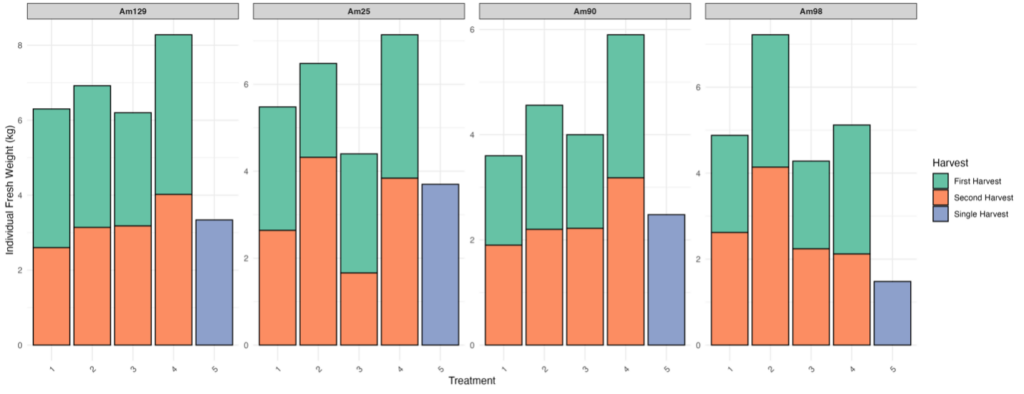
Consumer interest surveys were disseminated at two local farmers markets in the summer of 2023 to gauge consumer interest in leafy green amaranth as a novel summer leafy green or a culturally preferred crop. Of the 31 respondents, the largest demographic proportions came from North America, Europe, and East Asia. Of those ethnic regions, East Asia was previously identified as an area that was culturally familiar with leafy amaranth. 35.5% of respondents reported that they purchased culturally relevant foods monthly, while 29% reported weekly purchasing of culturally relevant food items. Among these consumers, 45.2% were interested in purchasing amaranth as a novel summer leafy green and 22.6% were interested in purchasing it as a substitute for other leafy greens, since locally sourced leafy greens are not consistently available in the summer (Figure 5). 22.6% of respondents did not answer this question, which could have been attributed to a language barrier with the respondents. Surveys were translated from English to Mandarin and Spanish, but due to translation restrictions while the surveys were completed, non-English speaking respondents could not ask for clarification on questions, leading them to leave the question blank. In the future, customer feedback surveys should be continued and involving a more ethnically diverse pool of respondents across New Jersey. This will ensure greater insights and linking new crop introductions to best meet consumer demands and preferences.
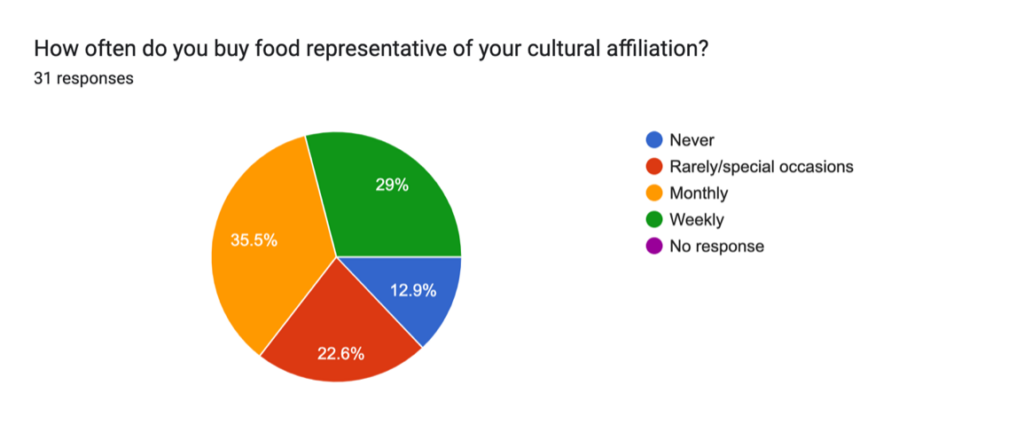
Leafy green amaranth has a significant market potential in New Jersey and the greater Northeastern United States due to its ethnically diverse population and consumer interest in leafy amaranth either as a novel summer green or a staple crop among migrant communities. Amaranth is unique in that it is a heat-loving leafy green, it has high nutrient density and can be produced in an indoor and outdoor environment for year-round access. While leafy amaranth has traditionally been cultivated as an outdoor crop in tropical regions of the world, growing demand for high-quality, clean, nutrient-dense produce prompts the production of indoor leafy greens, which offer locally sourced produce in urban areas during all seasons. Amaranth also has excellent regrowth, allowing for multiple harvests off of a single plant, which is beneficial for small-scale farmers to maximize the biomass that they take to market throughout the summer, with minimal plants to take care of. Small-scale specialty crop farmers in New Jersey should be early adopters of leafy amaranth, which will allow them to offer a competitive edge over those that grow more conventional produce, particularly in areas with a culturally diverse demographic. Nutritional evaluation of these crops in different growing conditions should continue, as that can guide our new plant selections in the development for new amaranth varieties. The initial market surveys were helpful and as this work continues such surveys need to be expanded to ensure a greater representation of New Jersey’s diverse population. Long-term monitoring should be continued for weed management strategies, commercial stability, post-harvest processing, and market acceptance and growth.
This NE-SARE research study shows that leafy amaranth represents a unique market opportunity that addresses multiple challenges in the Northeastern United States agricultural system. Through careful variety selection and cultivation trials, we have identified four promising amaranth varieties that not only perform well in both field and hydroponic systems, but also align with distinct cultural preferences in our target communities. As we move toward commercialization of these varieties, this project exemplifies how agricultural research can simultaneously address food security, cultural inclusivity, and economic opportunity for local farmers while advancing sustainable food production in an increasingly diversified American food landscape.
Education & outreach activities and participation summary
Participation summary:
This research was presented at the annual New Jersey Vegetable Growers Conference for 2 consecutive years and Rutgers Climate Symposium in Fall 2023. This project was also selected as one of the five top poster abstracts at the Urban Food Systems Symposium hosted by Ohio State University in the summer of 2024. Public and private farm tours were given to showcase our amaranth summer field plots, catering to outdoor and indoor specialty crop farmers. A talk on this project was also given at the 2023 annual Northeast SARE summer farm tour to Northeast farmers and extension agents to highlight amaranth as a new specialty crop. Additionally, we used a science-in-action video storytelling approach that documented the scientific process and impact of culturally preferred produce with the video being shown to audiences at a Rutgers Science-in-Action alumni event in the fall of 2023, the 2024 Planet Forward conference at George Washington University, and the Syracuse-SUNY ESF Environmental Storytelling Seminar Series in the fall of 2024 reaching over 200 people and now also available through this project's SARE page for longer-term access.
Project Outcomes
Our extension work has highlighted the importance of amaranth as a climate-resilient crop, due to its resistance to abiotic stresses, namely drought and heat stress. We highlight the importance of adapting our agricultural models to find more climate-resilient crop alternatives to traditional leafy greens. Our showcasing of amaranth at farmers markets has helped introduce the crop to climate-smart shoppers, who prioritize locally grown seasonal produce at farmers markets. Consumers are excited about the idea of a replacement for spinach in the summer months and even without cultural familiarity, are willing to buy it as a locally sourced replacement. In our extension work, we also make a clear effort to discuss avoiding the production of flowers on plants in the field, to reduce its likelihood to grow in subsequent years. By harvesting the complete plant 5 weeks after sowing, we are ensuring that it does not grow back and begin to flower.
We have learned a great deal about prioritizing data collected in consumer surveys. There were questions that we had originally found very straightforward which we learned that participants struggled to understand. We also learned the importance in keeping surveys short, as participants are much less likely to have meaningful responses in surveys over 3-5 minutes, especially as they are shopping at the farmers markets.
We have also learned that hydroponic production takes an enormous amount of trial and error, even when everything looks good on paper. There is almost no literature on hydroponic production of amaranth, so parameters were based mostly on spinach production. Even with pH and EC values looking good on paper, plants may still struggle to survive for a variety of reasons. For example, we have struggled with finding a soilless substrate that limits algae growth and has a lower water holding capacity, as amaranth does not require a lot of water to grow. These unanticipated results have led to many more research questions and ultimately we aim to publish a guide to hydroponic cultivation of amaranth for indoor growers in the Northeast.
